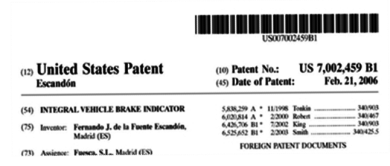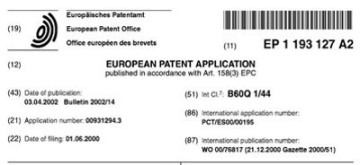
Complies regulations and Patent
Patent No. US 7,002,459 B1. EP 1 193 127 A2
"Automakers will be allowed to apply for exemptions to certain rules as part of an approach to ensure the government doesn’t stand in the way of technological progress."
Anthony Foxx. US Secretary of Transport. February 10, 2016 — 3:29 AM CET Transportation Secretary. BloombergBusiness.
The system complies according to UNECE wp 29.
Regulation Nº 48.
Addendum 47: Regulation No. 48 Revision 12
E/ECE/324/Rev.1/Add.47/Rev.12
E/ECE/TRANS/505/Rev.1/Add.47/Rev.12
16 October 2014
http://www.unece.org/fileadmin/DAM/trans/main/wp29/wp29regs/updates/R048r12e.pdf
2.7.1.3. "Variable intensity control" means the device which automatically controls rear light signalling devices producing variable luminous intensities to assure the unvarying perception of their signals. The variable intensity control is part of the lamp, or part of the vehicle, or split between the said lamp and the vehicle.
2.10. The "apparent surface" for a defined direction of observation means, at the request of the manufacturer or his duly accredited representative, the orthogonal projection of:
Either the boundary of the illuminating surface projected on the exterior surface of the lens;
Or the light-emitting surface;
Only in the case of a light-signalling device producing variable luminous intensities, its apparent surface that may be variable as specified in paragraph 2.7.1.3. shall be considered under all
conditions permitted by the variable intensity control, if applicable
In a plane perpendicular to the direction of observation and tangential to the most exterior point of the lens. Different examples of the application of apparent surface can be found in Annex 3 to this Regulation.
5. General specifications
5.9.2.The photometric characteristics of any lamp may vary:
5.26.
Rear direction-indicator lamps, rear position lamps, stop lamps (except stop lamps of category S4) and rear fog lamps with variable luminous intensity control are allowed, which respond simultaneously to at least one of the following external influences: ambient lighting, fog, snowfall, rain, spray, dust clouds, contamination of the light emitting surface, provided that their prescribed intensity relationship is maintained throughout variation transitions. No sharp variation of intensity shall be observed during transition.
Stop lamps of category S4 may produce variable luminous intensity independent from the other lamps. It may be possible for the driver to set the functions above to luminous intensities corresponding to their steady category and to return them to their automatic variable category.
Insert a new paragraph 2.36., to read:
2.36. "Sequential activation" means an electrical connection where the individual light sources of a lamp are wired such that they are activated in a predetermined sequence."
Regulation Nº 7.
Addendum 6: Regulation No. 7 Revision 6
E/ECE/324/Add.6/Rev.6
E/ECE/TRANS/505/Add.6/Rev.6
22 November 2012
http://www.unece.org/fileadmin/DAM/trans/main/wp29/wp29regs/updates/R007r6e.pdf
1.3. "Stop-lamp" means the lamp used to indicate to other road-users to the rear of the vehicle that its driver is applying the service brake. The stop-lamps may be activated by the application of a retarder or a similar device;
2.1.4. Whether the device produces steady luminous intensity (category R, R1, RM1, S1 or S3) or variable luminous intensity (category R2, RM2, S2 or S4);
2.14. Whether the device produces steady luminous intensity (category R, R1, RM1, S1 or S3) or variable luminous intensity (category R2, RM2, S2 or S4);
On devices meeting the requirements of this Regulation in respect of the stop-lamps, the letter "S" followed by the figure: "1" "2" "3" "4" When the device produces steady luminous intensity; When the device produces variable luminous intensity; When the device meets the specific requirements for category S3 stop- lamps and produces steady luminous intensity; When the device meets the specific requirements for category S4 stop- lamps and produces variable luminous intensity;


